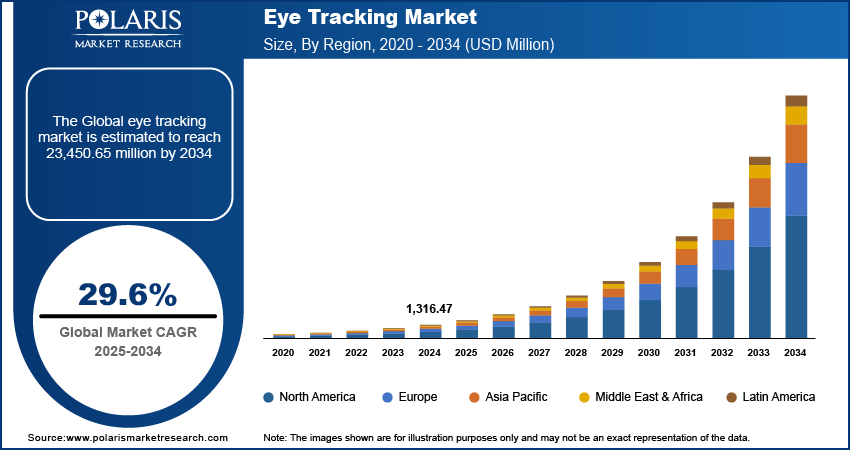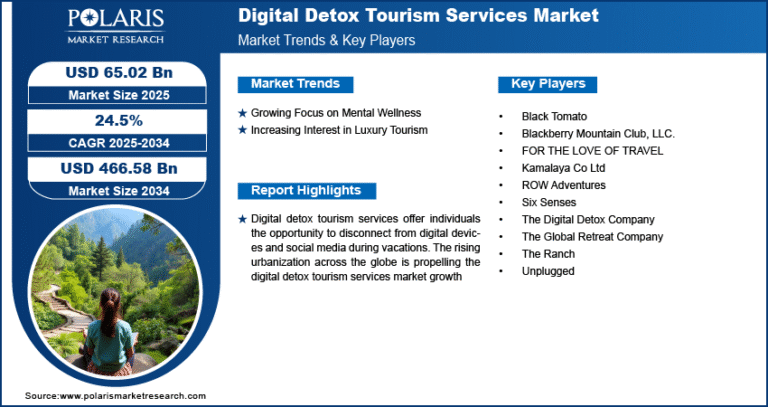Eye Tracking Market Projected to Reach USD 23,450.65 Million by 2034, Exhibiting a CAGR of 29.6%

The global eye tracking market was valued at USD 1,316.47 million in 2024 and is expected to grow significantly, reaching USD 23,450.65 million by 2034. The market is projected to expand from USD 1,754.07 million in 2025 at a robust compound annual growth rate (CAGR) of 29.6% during the forecast period from 2025 to 2034.
Key Market Drivers & Trends
- Healthcare & Clinical Diagnostics
- Used in diagnosing neurological conditions (e.g., Alzheimer’s, ADHD, autism) and assistive devices for motor impairments
- Healthcare held ~28–30% market share in 2023.
- Integrated into advanced driver assistance systems (ADAS) to detect drowsiness and distraction
- About 27–31% of market share is automotive focused
- Essential for foveated rendering and immersive experiences; VR/AR accounts for ~24% of market application.
- Wearable eye tracking—like in VR headsets—is the fastest-growing technology type.
- Adoption expected to reach ~80% in XR headsets by 2024.
- Shift toward sophisticated analytics platforms; software CAGR ~32% through 2032.
- Edge AI and ML enhance real-time gaze mapping and privacy-aware systems.
- Use cases in mobile devices and UX studies are expanding
Market Size & Forecast
- Market Size in 2024 – USD 1,316.47 million
- Market Size in 2025 – USD 1,754.07 million
- Projected Market Size by 2034 – USD 23,450.65 million
- CAGR (2025–2034) – 29.6%
Request a free sample copy or view report summary: https://www.polarismarketresearch.com/industry-analysis/eye-tracking-market/request-for-sample
Market Overview
Eye tracking technology—encompassing both remote and head-mounted systems—utilizes infrared sensors and high-speed cameras to monitor eye movement, pupil dilation, and gaze fixation points in real time. These insights are instrumental in enhancing user experience design, diagnosing cognitive impairments, improving driver safety, and optimizing consumer engagement strategies. The integration of eye tracking into augmented reality (AR), virtual reality (VR), and mixed reality (MR) platforms is further accelerating adoption, particularly in immersive simulation environments used for training, therapy, and product testing.
A primary driver fueling this market’s expansion is the rising demand for advanced driver assistance systems (ADAS) and autonomous vehicle technologies. Automotive manufacturers such as Tesla, BMW, and Toyota are incorporating eye tracking into driver monitoring systems (DMS) to detect signs of drowsiness, distraction, or fatigue, aligning with evolving regulatory mandates on road safety. In the United States, the National Highway Traffic Safety Administration (NHTSA) has endorsed the use of biometric monitoring tools as part of its Vision Zero initiative aimed at eliminating traffic fatalities, thereby reinforcing the necessity of integrated eye tracking solutions.






